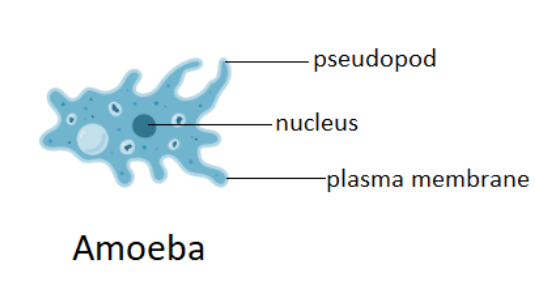
The process of reproduction in Amoeba starts with division of its body into parts followed by the division of its nucleus into two nuclear.
A. True
B. False
C. Ambiguous
D. Data insufficient
Answer
563.7k+ views
Hint: A cell or a unicellular organism that has the potential to alter its shape by primarily extending pseudopods is called an Amoeba. Amoeba is often referred to as an amoeboid cell. Amoeboid cells are present in almost all organisms such as animals, algae, fungi, and protozoa.
Complete answer: A unicellular organism that can alter its shape accordingly to the surrounding is called an Amoeba. These cells are placed in a subphylum called Sarcodina. Sarcodina is a grouping of single-celled organisms that bear pseudopods or locomotives by the protoplasmic flow. The mode of reproduction of amoeba is asexual. Amoeba reproduces by binary fission. Binary fission is a type of asexual reproduction. In binary fission, the organism divides itself into two daughter cells. These daughter cells produced are genetically identical. Different types of binary fission are longitudinal binary fission, simple binary fission, oblique binary fission, and transverse binary fission. Organisms like archaebacteria reproduce by binary fission. Binary type of cell division is also used by some organelles within the eukaryotic organisms. Each daughter cell produced has the ability to grow to the size of the parent organism. Steps involved in binary fission are as follows. Replication of single DNA takes place and then it is attached to the different parts of the membrane. The duplicated and original chromosome separates forming two cells when the cell begins to pull apart.

So, option B is the correct option.
Note: The process of mitosis and binary fission produces two identical daughter cells from one cell. The difference in both these processes is mitosis occurs in eukaryotic organisms which consist of a true nucleus whereas binary fission occurs mostly in prokaryotes without the true nucleus.
Complete answer: A unicellular organism that can alter its shape accordingly to the surrounding is called an Amoeba. These cells are placed in a subphylum called Sarcodina. Sarcodina is a grouping of single-celled organisms that bear pseudopods or locomotives by the protoplasmic flow. The mode of reproduction of amoeba is asexual. Amoeba reproduces by binary fission. Binary fission is a type of asexual reproduction. In binary fission, the organism divides itself into two daughter cells. These daughter cells produced are genetically identical. Different types of binary fission are longitudinal binary fission, simple binary fission, oblique binary fission, and transverse binary fission. Organisms like archaebacteria reproduce by binary fission. Binary type of cell division is also used by some organelles within the eukaryotic organisms. Each daughter cell produced has the ability to grow to the size of the parent organism. Steps involved in binary fission are as follows. Replication of single DNA takes place and then it is attached to the different parts of the membrane. The duplicated and original chromosome separates forming two cells when the cell begins to pull apart.

So, option B is the correct option.
Note: The process of mitosis and binary fission produces two identical daughter cells from one cell. The difference in both these processes is mitosis occurs in eukaryotic organisms which consist of a true nucleus whereas binary fission occurs mostly in prokaryotes without the true nucleus.
Recently Updated Pages
A man running at a speed 5 ms is viewed in the side class 12 physics CBSE

State and explain Hardy Weinbergs Principle class 12 biology CBSE

Which of the following statements is wrong a Amnion class 12 biology CBSE

Two Planoconcave lenses 1 and 2 of glass of refractive class 12 physics CBSE

The compound 2 methyl 2 butene on reaction with NaIO4 class 12 chemistry CBSE

Bacterial cell wall is made up of A Cellulose B Hemicellulose class 12 biology CBSE

Trending doubts
What are the major means of transport Explain each class 12 social science CBSE

Which are the Top 10 Largest Countries of the World?

Draw a labelled sketch of the human eye class 12 physics CBSE

Explain sex determination in humans with line diag class 12 biology CBSE

Give 10 examples of unisexual and bisexual flowers

State the principle of an ac generator and explain class 12 physics CBSE




